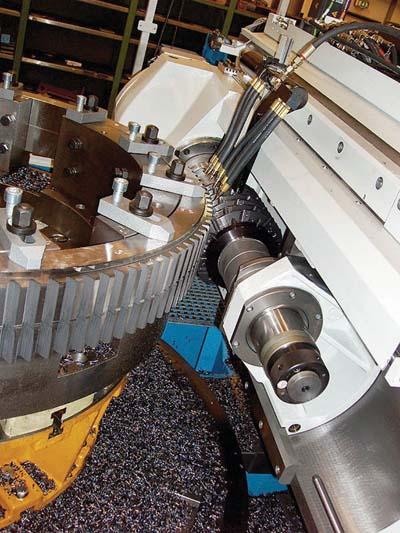
The first technology advancement for large VTCs resulting from MAG's recent acquisition of Modul, a gear manufacturing equipment specialist in Germany, introduces integrated gear cutting capability on a VTC 2500H (vertical turning center) for workpieces up to 2700mm diameter. The new multi-axis machine combines gear hobbing and milling capabilities with the VTC's wide range of turning, milling, drilling, threading and contouring capabilities. It can turn blanks and subsequently cut gear teeth, all in one setup. The machine's ability to execute rough turning of the outside diameter and gear cutting on the inside diameter in one set up results in higher quality gears. It also eliminates a separate gear cutting machine and reduces labor, part transfers, setups, work-in-process and plant footprint/overhead.
Gear production capabilities include hobbing, form milling (of external and internal gears), turn-milling of gear teeth with carbide end mills, and chamfering/deburring. This system is ideal for the part making requirements of the wind and power generation industries, mining equipment, marine and other heavy machinery.
The hobbing module is fully integrated into the VTC to allow turning, milling and hobbing or form milling of internal and external geared slewing rings. Two different heads are available with 36 or 46 kW power. They can hob modules up to 24.0mm or form-mill teeth up to module 28.0mm on parts with a maximum face width of 600mm.
The functionality of the gear manufacturing software is fully integrated into the turning center's control with one common HMI, so programming gear cutting operations is simple and intuitive. Features include workshop-oriented dialog for input of all geometric and technical parameters for the workpiece and hob.
In addition to gear cutting, MAG's VTCs can perform standard and hard turning, as well as live-spindle machining, contouring and part probing operations on multiple sides and the full diameter of a part. Customer-driven features include use of standard modular tooling, such as KM 80 and Coromant Capto solutions, as well as automatic tool changers; green design with minimal hydraulics; minimal or flat-floor foundation requirements for many models; and innovative chip management and removal that minimizes operator intervention. A full machine enclosure meets CE specifications and ensures a dry floor environment.
Contact Details
Related Glossary Terms
- gang cutting ( milling)
gang cutting ( milling)
Machining with several cutters mounted on a single arbor, generally for simultaneous cutting.
- hard turning
hard turning
Single-point cutting of a workpiece that has a hardness value higher than 45 HRC.
- milling
milling
Machining operation in which metal or other material is removed by applying power to a rotating cutter. In vertical milling, the cutting tool is mounted vertically on the spindle. In horizontal milling, the cutting tool is mounted horizontally, either directly on the spindle or on an arbor. Horizontal milling is further broken down into conventional milling, where the cutter rotates opposite the direction of feed, or “up” into the workpiece; and climb milling, where the cutter rotates in the direction of feed, or “down” into the workpiece. Milling operations include plane or surface milling, endmilling, facemilling, angle milling, form milling and profiling.
- modular tooling
modular tooling
1. Tooling system comprised of standardized tools and toolholders. 2. Devices that allow rapid mounting and replacement of tools. Commonly used with carousel toolchangers and other computerized machining operations. See toolchanger; toolholder.
- threading
threading
Process of both external (e.g., thread milling) and internal (e.g., tapping, thread milling) cutting, turning and rolling of threads into particular material. Standardized specifications are available to determine the desired results of the threading process. Numerous thread-series designations are written for specific applications. Threading often is performed on a lathe. Specifications such as thread height are critical in determining the strength of the threads. The material used is taken into consideration in determining the expected results of any particular application for that threaded piece. In external threading, a calculated depth is required as well as a particular angle to the cut. To perform internal threading, the exact diameter to bore the hole is critical before threading. The threads are distinguished from one another by the amount of tolerance and/or allowance that is specified. See turning.
- turning
turning
Workpiece is held in a chuck, mounted on a face plate or secured between centers and rotated while a cutting tool, normally a single-point tool, is fed into it along its periphery or across its end or face. Takes the form of straight turning (cutting along the periphery of the workpiece); taper turning (creating a taper); step turning (turning different-size diameters on the same work); chamfering (beveling an edge or shoulder); facing (cutting on an end); turning threads (usually external but can be internal); roughing (high-volume metal removal); and finishing (final light cuts). Performed on lathes, turning centers, chucking machines, automatic screw machines and similar machines.







